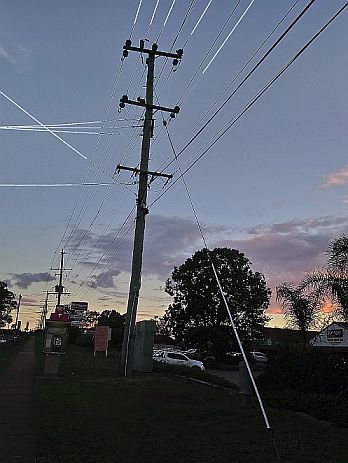Newton’s laws of motion
In the 17th century Sir Isaac Newton developed three laws that explain why things move (or don’t move) in the way they do. They are commonly known as Newton’s laws of motion. These laws apply to all types of objects including planets1 and power poles (as long as their speed is much smaller than the speed of light in a vacuum!). In particular, these laws can be used to describe how poles, conductors, stays and wind loads behave and interact.

The first law is often stated as
An object at rest stays at rest and an object in motion stays in motion with the same speed and in the same direction unless acted upon by an unbalanced force.2
A power pole is at rest and remains at rest3. It is in static equilibrium meaning the forces acting on it are balanced. What types of forces act on a pole?
- conductor tension and weight
- wind pressure
- self weight of the pole
- weight of other components eg crossarms, plant, insulators
- accidental forces eg an object hitting the pole, seismic action etc
The second law is commonly expressed as
The change of momentum of an object is directly proportional to and collinear with the impulse applied to it.
This law is relevant only in situations where dynamic events occur.
Newton’s third law is
For every action, there is an equal and opposite reaction.
This means that when the forces listed above act on the pole there are reactions to them. What are the reactions? There is the foundation, maintaining the pole in a vertical position, and the resistance of any stays. (The strength of the pole is a material property not a reaction force.)
Summation of forces
Equilibrium means the net force acting on an object (a power pole in our case) is zero. The net force is the vector sum of all the forces4.
Similar summation of forces can be seen in references for power line design such as AS/NZS 7000:20165 \( \phi R_{n}> \Sigma \gamma _{x} X\) where \(X\) represents the applied loads relevant to each loading condition. Note that \(\Sigma \gamma _{x} X\) can be augmented with the reaction force in the foundation \(– R_{f}\) to obtain the net force \( -R_{f}+ \Sigma X=0\) being equal to zero in the case of equilibrium. Hence the principle actions equal reactions \( R_{f}= \Sigma X\) where the forces are all written in magnitudes. In other words if the force of the foundation on the pole is less than the strength of the pole, the pole is safe (\( R_{f}<\phi R_{n}\)).
Overhead Power Lines (Kiessling et al) puts it as \(E_{d} \leq R_{d}\), where \(E_{d}\) is the total design value of the effect of action and \(R_{d}\) the corresponding structural design resistance. 6
Using the simplification when calculating tiploads that
- the forces acting on a pole are in the horizontal plane only
- they are acting at the top of the pole
- the point of zero moment is the pole base (usually ground level)
the forces can be resolved into two components perpendicular to each other7. This makes it easier to allow for the direction of the conductors and wind. Any “zero” direction can be used for the vector components but 0º and 90º are easy to picture.

There can be multiple forces acting on a pole—several circuits going in different directions, wind load on the pole, perhaps a transformer on one side of the pole. There can be multiple reaction forces too—foundation and one or more stays.
Some conclusions from these principles:
- The forces (conductor tension, wind etc) can be added together vectorially to give one equivalent resultant load. This is convenient because this becomes the unstayed tipload on the pole.
- The forces and reactions are one system that interact together—it is not that one reaction force eg the tension in a stay, is a reaction to one other force eg a tension in a conductor span. Each of the forces and reactions interact with all the other forces and reactions.
- The reaction force in any particular component eg a stay, is dependent on the other reaction forces and can be complex to calculate. This reaction force tells us the required strength of the stay or pole.
References
NASA, https://www.grc.nasa.gov/WWW/K-12/airplane/equilib.html
NASA, https://www.grc.nasa.gov/WWW/K-12/WindTunnel/Activities
The Physics Library, https://phys.libretexts.org/Bookshelves/University_Physics/Book%3A_University_Physics_(OpenStax)/Map%3A_University_Physics_I_-Mechanics%2C_Sound%2C_Oscillations%2C_and_Waves(OpenStax)/12%3A_Static_Equilibrium_and_Elasticity/12.E%3A_Static_Equilibrium_and_Elasticity_(Exercises)/balance_of_forces.html
The Physics Classroom, https://www.physicsclassroom.com/
Overhead Power Lines, F. Kiessling, P. Nefzger, J. F. Nolasco, U. Kaintzyk
- https://education.seattlepi.com/newton-explain-planetary-motion-6264.html
- https://www.physicsclassroom.com/class/newtlaws/Lesson-1/Newton-s-First-Law
- unless an unbalanced load is applied
- https://www.physicsclassroom.com/class/vectors/Lesson-3/Equilibrium-and-Statics
- AS/NZS7000:2016 eqn 6.1
- Overhead Power Lines, F. Kiessling, P. Nefzger, J. F. Nolasco, U. Kaintzyk, page 369
- https://www.physicsclassroom.com/Class/vectors/u3l1d.cfm